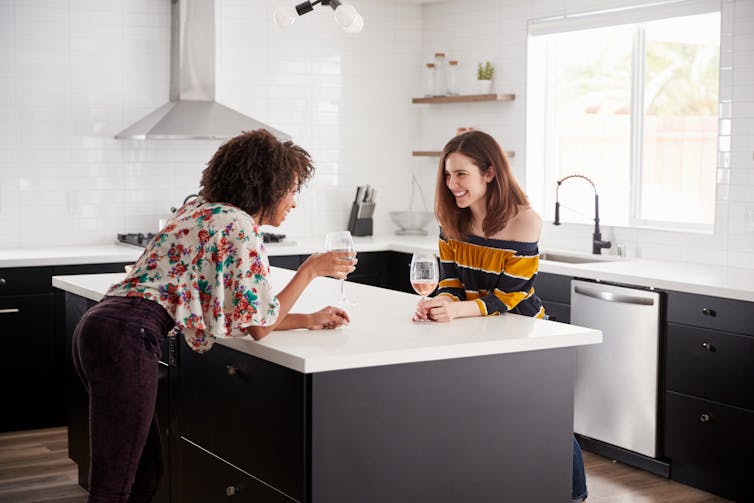Source: The Conversation (Au and NZ) – By Ryan Hoy, Respiratory Physician. Senior Research Fellow. Monash Centre for Occupational and Environmental Health, Monash University
In 2012 my wife and I renovated our house — a two-storey extension with a brand new kitchen. Inspired by various renovation-themed TV shows and magazines, we chose a sleek stone island bench as the focal point for the kitchen.
I knew the benchtop material was some form of stone. You could choose almost any colour and it cost a lot less than marble. But I didn’t know much else and I didn’t ask any questions. As a respiratory physician who has diagnosed numerous workers with silicosis over the past four years, I regret my ignorance.
Like many Australians who have renovated or built homes since the early 2000s, the material we chose was artificial stone (also known as engineered or reconstituted stone, or quartz).
In 2015, after the first Australian stone benchtop industry worker was reported to have severe silicosis, I was astonished to discover artificial stone contains up to 95% crystalline silica.
Inhalation of crystalline silica dust is one of the best-known causes of lung disease, including silicosis and lung cancer. The adverse health effects of silica exposure were established while there was still debate about the harm of cigarettes and asbestos. But Australians’ affinity for artificial stone benchtops has seen silicosis make a major comeback in recent years.New research in Victoria shows the extent of silicosis among workers in the stone benchtop industry.
Read more: Explainer: what is silicosis and why is this old lung disease making a comeback?
What is silicosis?
Silicosis is a preventable disease characterised by scarring on the lungs, called pulmonary fibrosis.
Over time, inhalation of tiny silica dust particles triggers an inflammatory response that causes small growths called nodules to build up on the lungs. These nodules can grow and cluster together, causing the lungs to become stiffer and impeding the transfer of oxygen into the blood.
In the early stages of the disease, a person may be well. Symptoms of silicosis can include a cough, breathlessness and tiredness. Generally, the more widespread the disease becomes in the lungs, the more trouble a person will have with breathing.
There’s not currently a cure. In severe cases, a lung transplant may be the only option, and the disease can be fatal.
Brisbane researchers, however, recently demonstrated early but promising results from a trial in which they washed silica out of a small number of silicosis patients’ lungs.

The road to reform
Tradesmen in the stone benchtop industry cut slabs of stone to size and use hand-held power saws and grinders to form holes for sinks and stove tops. This generates crystalline silica dust from the stone which may be released into the air.
Using water in this process can suppress the generation of dust significantly, but until recently dry processing of artificial stone has been ubiquitous in the industry. Almost 70% of workers with silicosis in Victoria indicated they spent more than half their time at work in an environment where dry processing was occurring.
Stone benchtop workers suffering silicosis have called out poor work conditions over recent years, including being made to perform dry cutting with inadequate protections such as effective ventilation and appropriate respirators.
Queensland was the first state to ban dry cutting in 2018. Victoria followed in 2019, and New South Wales in 2020.
It’s too early to assess whether these changes have affected the prevalence of silicosis, but hopefully they will make a difference.
Our research
Around the time the Victorian government introduced the ban, it launched an enforcement blitz in high-risk workplaces, while WorkSafe Victoria implemented a free screening program for the estimated 1,400 workers in the stone benchtop industry across the state.
The Monash Centre for Occupational and Environmental Health recently released a report detailing the findings from the first year of the screening program. Some 18% of initial 324 workers who completed the assessments were diagnosed with silicosis.

We’ve seen similar results in Queensland, where as of February 2021 the government had screened 1,053 stonemasons exposed to crystalline silica dust from artificial stone. Some 223 (or 21%) were diagnosed with silicosis, including 32 with the most severe form, called progressive massive fibrosis.
The Monash report indicates workers in Victoria are diagnosed with silicosis at an average age of just 41. The average time spent working in the stone benchtop industry when diagnosed was 14 years, and the shortest was just three years, reflecting an extremely high level of silica dust exposure.
We published some earlier results of this research project in Occupational and Environmental Medicine late last year. But this latest data hasn’t yet been published in a peer-reviewed journal, meaning it hasn’t been subject to the same level of scrutiny as other published research.
A broader problem
Failure to protect workers from silica exposure goes well beyond the stone benchtop industry.
Around 3.7% of Australian workers are estimated to be highly exposed to silica at work, and we see workers in other industries, such as quarry work, with silicosis too.
Some 59% of Earth’s crust is silica, so in certain workplaces such as mines and quarries, eliminating silica is not feasible.
In these circumstances, exposure must be identified and tightly controlled with measures to prevent dust generation, isolation of workers from the dust, and effective ventilation. If silica cannot be eliminated from a workplace, constant vigilance and evaluation of control strategies are essential.
Read more: Engineered stone benchtops are killing our tradies. Here’s why a ban’s the only answer
But when it comes to the choice of material for your kitchen benchtop, it’s hard to argue elimination of high-silica artificial stone isn’t feasible. There are many other materials suitable for benchtops that contain little or no silica, such as wood, laminate, steel or marble.
Compared with other countries, Australian consumers have developed a particular fondness for artificial stone, which accounts for 45% of the benchtop market here, but just 14% in the United States.
Workers’ lung health may seem like a strange thing to contemplate when designing a kitchen. But increased awareness of this issue is crucial to drive change.
– ref. Renovating your kitchen? Help Australia’s tradies avoid silicosis by not choosing artificial stone – https://theconversation.com/renovating-your-kitchen-help-australias-tradies-avoid-silicosis-by-not-choosing-artificial-stone-156208








